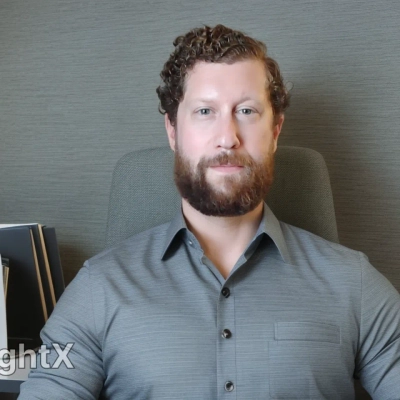8 Surprising Therapeutic Techniques That Changed How Professionals Approach Patient Care
Leading experts reveal unconventional therapeutic techniques that are transforming patient care in surprising and effective ways. The field of therapy continues to evolve with innovative approaches that connect mind and body while personalizing treatment to individual needs. From nutritional psychiatry to somatic techniques, these evidence-based methods are changing how professionals understand and address their clients' challenges.
Personalize Therapy Through Client Interests
Incorporating clients' personal interests into therapeutic approaches has proven remarkably effective, particularly when I worked with a client who enjoyed painting. By transforming their artistic expression into a structured technique for managing anxiety and reducing stress, we discovered a powerful personalized coping mechanism that resonated deeply with them. This experience reinforced my belief in tailoring treatment plans to each individual's unique strengths and interests rather than relying solely on standardized approaches. I now regularly explore clients' hobbies and passions early in treatment to identify potential therapeutic tools that will feel natural and meaningful to them.

Humor Creates Space in Therapeutic Work
I've found that incorporating humor into therapy sessions has been surprisingly effective with many clients. By sharing relevant comedy clips or occasionally texting mental health memes, I've observed significant shifts in emotional states, with one client specifically noting that laughter served as "great medicine" for them. This feedback reinforced what research suggests about humor's ability to reset nervous system activation and create psychological space during difficult therapeutic work. Based on these positive outcomes, I now more intentionally integrate appropriate humor as a complementary approach alongside traditional therapeutic techniques when suitable for the client's needs and preferences.

Somatic Bridges Connect Emotions to Memories
Working in Community Mental Health many years ago, my caseload was made up of a significant portion of court-mandated clients. One was actively and persistently psychotic and diagnosed by her psychiatric provider with borderline personality and brief psychotic episode. She was recently released from jail related to stalking her ex and violating a PFA. During therapy, she was largely unable to express herself - a phenomenon we refer to as "thought blocking."
She was clearly having strong visceral experiences of anxiety, so we focused on this sensation and what memories it might elicit. This is called a somatic bridge. The client associated to hiding in the backyard, sometimes for hours, to avoid an abusive parent. Not only did this allow for processing of a traumatic but avoided memory, but also providing meaning for the compulsion to keeps eyes on her ex: she wasn't stalking him so much as keeping an eye on her daughter who had just turned the same age (12) as she had been in the traumatic memory of hiding in the backyard. On her daughter's 12th birthday, she started to have anxiety and a compulsion not to let her out of sight, but the experience was fragmented - the factual information was repressed: the memory of the trauma or thought "I'm worried about my daughter's safety because of what happened to me at that age" was absent. Consequently, she had little ability to explore the experience and make a thoughtful decision or cope.
After this somatic bridge, the client was much more expressive in session. We had been doing vocational work as she needed to land a job. Shortly thereafter, she did find work. Her panic-like anxiety was notably reduced and no longer had the compulsion to keep a watchful eye on her ex (more specifically, her daughter).
Of note, this trauma was not unknown - it was not a "new" memory, so much as one that was at the time of therapy, behind a curtain from conscious experiencing, presumably an (unconscious) defense mechanism (repression): recalling that memory might have felt like too much on top of everything else. However, this also precluded incorporating important information from that memory and processing it. Consequently, the client was a reacting as if she was back in that dangerous situation except the role of victim was projected onto her daughter, the role of persecutor onto her ex, and she took the role of savior (trauma triangle). This projective identification resulted in her becoming the persecutor (stalking).

Body Awareness Builds Trust in Trauma Work
One technique that surprised me with its effectiveness was integrating somatic awareness into trauma work. In my experience, many clients understand their trauma on a cognitive level but still feel disconnected from their bodies. Incorporating somatic work helped bridge that gap by allowing clients to notice how emotions show up physically and to respond to those sensations with care rather than avoidance.
I worked with a client who often felt anxious and shut down during emotional conversations. Instead of focusing only on thoughts, we began paying attention to what was happening in her body when those feelings appeared. She noticed her chest tightening and her shoulders tensing. I guided her to slow down, breathe, and gently release the tension instead of pushing through it. Over time, she started recognizing these cues as early signs of stress rather than moments of danger. That awareness allowed her to regulate her emotions before they became overwhelming.
What surprised me most was how quickly this approach built trust, both within herself and in our therapeutic relationship. I think that when clients learn to listen to their bodies, they begin to experience healing in a more integrated way. They no longer see their reactions as something to fight against but as information that helps them feel safer.
This experience changed how I approach trauma recovery. I now place greater emphasis on nervous system regulation and attachment repair, helping clients build safety in the body before diving into deeper emotional work. In my opinion, this creates a stronger foundation for lasting healing because it helps people reconnect with themselves in a way that feels safe, grounded, and empowering.

Five Senses Grounding Empowers Panic Attack Management
Guided grounding through the five senses was particularly effective with a patient experiencing frequent panic attacks. During a session, I invited the client to name five things they could see, four they could touch, three they could hear, two they could smell, and one they could taste. To my surprise, this very concrete, sensory-based exercise calmed the patient's acute anxiety and gave them a sense of control they hadn't felt in months. They reported also using this technique independently and outside of therapy to prevent spiraling into a panic attack. This straightforward effectiveness reminded me that patients don't always need complex interventions to see real progress, sometimes the simplest, most tangible strategies can become cornerstones of coping. This also reinforced the value of collaboration, experimentation, and humility in clinical practice to deepen appreciation for the small, accessible strategies in mental health care.

Nutritional Psychiatry Complements Traditional Therapy Approaches
One technique that surprised me with its effectiveness has been incorporating lab-based nutritional psychiatry into treatment. In my experience, many clients come in believing their mental health struggles are purely psychological, but once we explore the biological side of things like nutrient levels, hormonal balance, and inflammation; it often opens up a new understanding of their symptoms. For me, connecting emotional health with measurable biological data helps clients feel validated and gives them hope that change is possible on multiple levels.
I worked with a patient who had been battling chronic anxiety and fatigue despite years of therapy and medication adjustments. After running lab tests, we discovered deficiencies that were directly impacting their mood and energy regulation. Once we addressed those imbalances alongside therapy, their anxiety began to ease, and they reported feeling clearer and more grounded. Seeing that shift reminded me that treating the mind and body together can often be more effective than focusing on one alone.
In my opinion, this integrative approach has changed the way I think about care. I no longer see therapy and biological treatment as separate tracks but as parts of the same conversation. When clients understand how their emotional experiences and physical health influence each other, they become more engaged in their own healing. That collaboration where the science and the story meet is where the most meaningful progress happens.

Simple Questions Transform Emotional Self-Understanding
One therapeutic technique that has consistently surprised me with its effectiveness is asking patients a simple question: "What am I feeling and why?" This straightforward practice helps patients pause, connect with their body, and name their feelings—effectively interrupting cycles of self-blame and anxiety. The speed with which patients can move from overwhelming emotions to clarity has been truly remarkable.
I recall a patient who arrived convinced they were "broken" because of persistent anxiety. When I guided them to notice the physical sensations beneath their anxiety and ask themselves that key question, they realized their anxiety wasn't random but a signal about a troubled work relationship. This insight transformed their perspective from helplessness to empowerment, allowing them to address the actual conflict rather than blame themselves.
This experience fundamentally shifted my approach to patient care. It reinforced that healing doesn't always require complex therapeutic interventions. Often, the most effective care involves creating space for patients to slow down, tune into their bodies, and trust the signals they're already receiving. Sometimes the simplest practices yield the most profound results.
Alexandria Williams, LPC
Founder of Therya | Creator of the Reflexe Method
**Short bio for reference:**
Alexandria Williams, LPC, is the founder of Therya and creator of the Reflexetm Method, a framework blending nervous system care, somatics, and emotional awareness. She helps anxious teens, young adults, and professionals feel instead of just function.

Internal Parts Work Redefines Pain Meaning
Having a client picture the internal part that held onto pain and having them identify it and then - redefine its meaning. I have used the technique many times since and it has made a massive difference for clients woth a variety of issues .


